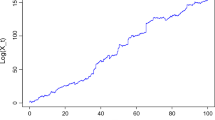Abstract
This paper considers a class of term structure models that is a parameterisation of the Shirakawa (1991) extension of the Heath et al. (1992) model to the case of jump-diffusions. We consider specific forward rate volatility structures that incorporate state dependent Wiener volatility functions and time dependent Poisson volatility functions. Within this framework, we discuss the Markovianisation issue, and obtain the corresponding affine term structure of interest rates. As a result we are able to obtain a broad tractable class of jump-diffusion term structure models. We relate our approach to the existing class of jump-diffusion term structure models whose starting point is a jump-diffusion process for the spot rate. In particular we obtain natural jump-diffusion versions of the Hull and White (1990, 1994) one-factor and two-factor models and the Ritchken and Sankarasubramanian (1995) model within the HJM framework. We also give some numerical simulations to gauge the effect of the jump-component on yield curves and the implications of various volatility specifications for the spot rate distribution.
Similar content being viewed by others
References
Baxter, M. and Rennie, A. (1996) Financial Calculus: An Introduction to Derivative Pricing, Cambridge University Press.
Bhar, R. and Chiarella, C. (1997) Transformation of Heath-Jarrow-Morton models to Markovian systems, European Journal of Finance 3, 1–26.
Björk, T. and Gombani, A. (1999) Minimal realisations for forward rates, Finance and Stochastics 3(4), 413–432.
Björk, T., Kabanov, Y., and Runggaldier, W. (1997) Bond market structure in the presence of marked point processes, Mathematical Finance 7(2), 211–239.
Björk, T. and Landèn, C. (2002) On the construction of finite dimensional realisations for nonlinear forward rate models, Finance and Stochastics 6(3), 303–329.
Björk, T. and Svensson, L. (2001) On the existence of finite dimensional realisations for nonlinear forward rate models, Mathematical Finance 11(2), 205–243.
Bremaud, P. (1981) Point Processes and Queues: Martingale Dynamics, Springer-Verlag.
Carverhill, A. (1994) When is the short rate Markovian, Mathematical Finance 4, 305–312.
Chacko, G. and Das, S. R. (2002) Pricing interest rate derivatives: A general approach, The Review of Financial Studies 15(1), 195–241.
Cheyette, O. (1992) Term structure dynamics and mortgage valuation, Journal of Fixed Income 1, 28–41.
Chiarella, C. and El-Hassan, N. (1996) A preference free partial differential equation for the term structure of interest rates, Financial Engineering and the Japanese Markets 3, 217–238.
Chiarella, C. and Kwon, O. (2001a) Forward rate dependent Markovian transformations of the Heath-Jarrow-Morton term structure model, Finance and Stochastics 5(2), 237–257.
Chiarella, C. and Kwon, O. (2001b) Formulation of popular interest models under the HJM framework, Asia Pacific Financial Markets 8(1), 1–22.
Chiarella, C. and Kwon, O. (2003) Finite dimensional affine realisations of HJM models in terms of forward rates and yields, Review of Derivatives Research 6(2), 129–155.
Chiarella, C., Schlögl, E., and Nikitopoulos, C. S. (2003) A defaultable term structure model with state dependent volatilities, School of Finance and Economics, UTS Working Paper.
Chiarella, C. and Tsô, T. D. (2003) The Jump component of the volatility structure of interest rate futures markets: An international comparison, Journal of Futures Markets 23, 1125–1158.
Chiarella, C. and Tô, T. D. (2004) Estimation of affine term structure models within the HJM framework, School of Finance and Economics, UTS Working Paper.
Das, S. R. (2002) The surprise element: Jumps in the interest rates, Journal of Econometrics 106, 27–65.
Das, S. R. (2000) Interest rate modelling with jump-diffusion processes. In N. Jegadeesh and B. Tuckman(eds), Advanced Fixed-Income Valuation Tools, John Wiley & Sons.
de Jong, F. and Santa-Clara, P. (1999) The dynamics of the forward interest rate curve: A formulation with state variables, Journal of Financial and Quantitative Analysis 34(1), 131–140.
Duffie, D. and Kan, R. (1996) A yield-factor model of interest rates, Mathematical Finance, 6(4), 379–406.
Glasserman, P. and Kou, S. G. (2003) The term structure of simple forward rates with jump risk, Mathematical Finance 13(3), 383–410.
Heath, D., Jarrow, R. A., and Morton, A. (1992) Bond pricing and the term structure of interest rates: A new methodology for contingent claims valuation, Econometrica 60, 77–105.
Hull, J. C. and White, A. (1990) Pricing interest rate derivative securities, The Review of Financial Studies 3(4), 573–592.
Hull, J. C. and White, A. (1994) Numerical procedures for implementing term structure models II: Two-facors models, Journal of Derivatives Winter, 37–49.
Inui, K. and Kijima, M. (1998) A Markovian framework in multi-factor Heath-Jarrow-Morton models, Journal of Financial and Quantitative Analysis, 33(3), 423–440.
Nikitopoulos, C. S. (2004) A class of Markovian models for the term structure of interest rates under jump-diffusions, School of Finance and Economics, University of Technology, Sydney, Ph.D. Thesis.
Ritchken, P. and Chuang, Y. (1999) Interest rate option pricing with volatility humps, Review of Derivatives Research 3, 237–262.
Ritchken, P. and Sankarasubramanian, L. (1995) Volatilities structures of forward rates and the dynamics of term structure, Mathematical Finance 5(1), 55–73.
Runggaldier, W. J. (2003) Jump-diffusion models. In S. T. Rachev (ed.), Handbook Heavy Tailed Distributions in Finance, Elsevier, North-Holland, pp. 169–209.
Shirakawa, H. (1991) Interest rate option pricing with Poisson–Gaussian forward rate curve processes, Mathematical Finance 1(4), 77–94.
Vasicek, O. (1977) An equilibrium characterisation of the term structure, Journal of Financial Economics 5, 177–188.
Author information
Authors and Affiliations
Corresponding author
Rights and permissions
About this article
Cite this article
Chiarella, C., Sklibosios, C.N. A Class of Jump-Diffusion Bond Pricing Models within the HJM Framework. Asia-Pacific Finan Markets 10, 87–127 (2003). https://doi.org/10.1007/s10690-005-6006-0
Published:
Issue Date:
DOI: https://doi.org/10.1007/s10690-005-6006-0




